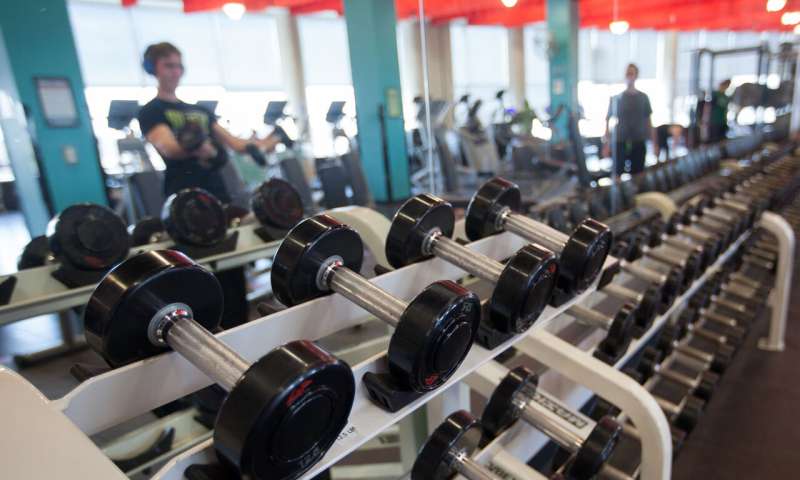Research shows resistance training can help reduce type 2 diabetes risk
A group of Oakland University researchers used data from medical studies around the world to examine the impact of resistance training on type 2 diabetes risk.
Their findings, published in the journal Sports Medicine, showed that resistance training such as weight lifting and resistance band exercise is helpful for controlling blood sugar and blood lipid (LDL, HDL and Triglycerides) levels—two of the most prominent risk factors for type 2 diabetes—in those at risk for the disease.
"Previous studies have shown that resistance training is effective for controlling glycemic (blood sugar) and blood lipid levels in adults who already have type 2 diabetes," said Raza Qadir, a recent OUWB graduate and the paper's lead author.
"Our research showed that resistance training is also useful for controlling those same variables, in addition to reducing body fat, in people who are at risk for developing the disease."
Along with Qadir, Elise Brown, an assistant professor in OU's School of Health Sciences, Taylor Todd, a student in OU's School of Health Sciences and Nicholas Sculthorpe, a professor in the School of Health and Life Sciences at the University of the West of Scotland, were co-authors on the paper. In addition, Brown served as faculty mentor to Qadir.
The OU researchers pulled data from controlled clinical trials that tracked cardiometabolic outcomes in adults with type 2 diabetes risk, comparing those who underwent a resistance training intervention with those who did not. Cardiometabolic outcomes refer to common risk factors that are linked to both cardiovascular diseases (e.g., coronary artery disease) and metabolic conditions (e.g., obesity, type 2 diabetes) such as abnormal blood lipid and blood sugar levels, high blood pressure and increased abdominal fat.
Sculthorpe performed the data analysis, which showed that resistance training, when performed over a period of at least 12 weeks, is effective in lowering blood sugar, body fat and blood lipids in adults who are at risk for type 2 diabetes.
"These findings have implications for type 2 diabetes prevention efforts," said Qadir, adding that long-term studies are needed to determine if regular resistance training can prevent the disease altogether. "If we can prevent the disease, we can avoid the health complications and costs associated with it."
The complications are many and varied. They include nerve, kidney and vision problems, along with increased risk for cardiovascular disease, the leading cause of death globally. Moreover, type 2 diabetes affects over 400 million people worldwide and has an estimated annual global cost of $1.3 trillion.
Looking at the data, the researchers found that the clinical trials that demonstrated the most significant improvements in cardiometabolic outcomes for patients at risk for type 2 diabetes employed specific training parameters—namely the use of free weights or resistance bands at intensities above 60% one-repetition maximum, with 10 to 15 repetitions at a time. This means an individual is using an intensity that is above 60% of the maximum amount of resistance they can move through an appropriate range of motion for one repetition using correct technique.
These findings align with exercise recommendations from the American Diabetes Association and American College of Sports Medicine for adults with type 2 diabetes, Qadir said. He noted that, in addition to supporting cardiometabolic health, resistance training is also used to improve athletic performance, body composition and bone density.
"Those benefits just strengthen the case for resistance training," he said.
Qadir started working on the project as an M1 in OUWB's Embark program, which provides students with scholarly research experiences under the supervision of a faculty mentor. His responsibilities on the project included design and conception of the study, screening of titles, abstracts, and full text articles, data extraction, risk of bias assessment, and manuscript draft and revisions. Qadir credits his faculty mentor, Elise Brown, with making his experience immensely valuable.
"She was the best mentor I could have asked for," he said. "She gave me full responsibility, while guiding me through every step of the research process."
Qadir graduated from OUWB in May and will serve a transitional year residency at St. Mary Mercy Livonia Hospital before moving on to an advanced residency in anesthesiology at the University of Chicago Medical Center. He believes his research experiences will make him a better physician to his future patients.
"As physicians, we should be experts in the critical appraisal of medical literature," he said. "Because a lot of times data gets misused or misinterpreted, which leads to conflicting reports and confusion among the public. Patients are going to ask our opinions on these topics, so we need to be able to evaluate the studies ourselves and provide the most accurate information."
He added, "This whole experience has given me an appreciation for everything that goes into research and hopefully will springboard my career and allow me to do more research in the future."
- Karlston
-

 1
1



Recommended Comments
There are no comments to display.
Join the conversation
You can post now and register later. If you have an account, sign in now to post with your account.
Note: Your post will require moderator approval before it will be visible.